A portrait painting is basically a picture that someone paints of a person’s face. It’s not just about drawing their face, but capturing their expression and personality too.
When you look at a portrait painting, you should feel like you’re looking at the real person. At our gallery, we have lots of portrait paintings that show this well.
Our artists are really good at taking a photo of someone and turning it into a beautiful painting that captures the important moments of that person’s life.
So, in simple words, a portrait painting is like a window to someone’s soul, showing who they are through their face and expression.
What is Portrait Painting?

Portrait paintings or drawings are like windows into someone’s life. When you look at a portrait, you’re not just seeing a face; you’re peering into the essence of a person or even an entire era.
In the past, people would sit for hours while an artist captured their likeness, but nowadays, artists can work from photographs.
A great portrait goes beyond mere appearance; it tells a story. Through clever expressions, poses, colors, or included objects, a portrait can reveal a lot about the sitter – their personality, their place in society, or even their beliefs.
These paintings aren’t just pretty pictures; they’re biographies in brushstrokes, captivating viewers and inviting them to delve into the life of the person depicted.
How Can One Analyze a Portrait?

Analyzing a portrait involves delving deeper into the artist’s portrayal of the subject and interpreting various elements to understand the message or story behind the artwork.
Here’s how you can approach it:
- Facial Expressions: Pay attention to the emotions conveyed through the subject’s facial expressions. Notice if they appear happy, sad, surprised, or angry. These expressions can offer insights into the subject’s inner feelings and experiences.
- Costume: Consider the clothing worn by the subject. Is it formal or casual? Is it fashionable or outdated? The choice of attire can suggest the subject’s social status, profession, or personal style, providing clues about their identity.
- Background Setting: Examine the backdrop of the portrait. The environment and objects surrounding the subject can reveal additional details about their life or circumstances. For instance, a cluttered room might indicate chaos or disorder, while a serene outdoor setting could symbolize tranquility.
- Pose of the Model: Analyze the subject’s body language and posture. Are they standing tall with confidence or slouched in defeat? The pose can convey a sense of strength, vulnerability, or relaxation, offering further insight into the subject’s personality and mood.
By considering these elements – facial expressions, costume, background setting, and pose – viewers can gain a deeper understanding of the subject and the artist’s intentions behind the portrait.
Keep in mind that interpretation may vary depending on individual perceptions, allowing for diverse and nuanced analyses of the artwork.
Styles of Portrait Painting

Portrait painting offers a diverse array of styles and techniques, each revealing unique insights about the subject and the artist’s intentions.
Let’s break down some key aspects:
- Portraits can be realistic, capturing every detail accurately, or they can be expressionistic, emphasizing emotions and mood over precise representation.
- Color Schemes: Artists can use conventional skin tones or unconventional colors to evoke different feelings. For example, Picasso’s Blue Period or Van Gogh’s self-portraits showcase how color choice can convey emotion effectively.
- Brushwork: The way an artist handles brushstrokes influences the mood of the portrait. Delicate strokes often convey sensitivity, while rough strokes offer a more expressive approach.
- Inclusion of Objects: Portraits can focus solely on the face or incorporate additional objects that provide context or symbolism, adding layers of meaning to the artwork.
- Dimensionality: Some portraits aim for a three-dimensional effect, making the subject appear lifelike, while others embrace the flatness of the canvas, experimenting with the two-dimensional nature of the medium.
- Completion: Finished portraits cover the entire canvas, but unfinished ones leave areas blank, inviting viewers to fill in the gaps with their imagination, creating intriguing compositions through suggestion rather than explicit depiction.
By considering these aspects, artists can craft portraits that convey a range of emotions and meanings, offering viewers a deeper understanding of the subjects portrayed.
Types of Portrait Drawing and Painting

Portraits, which are drawings or paintings of people, can be classified in various ways:
- Based on the Length of the Portrait:
- Full-length portrait: This type shows the entire body of the person. It was popular among royals and aristocrats in the past to display their status.
- Half-length portrait: These show the upper body, focusing mainly on the subject’s expression.
- Three-quarter portrait: These show about three-quarters of the body, from head to knee, but aren’t as common.
- Kit Kat Portraits: These show less than half of the body and often focus on the hands. They were popularized by portraits made for the Kit Cat Club members.
- Based on the Pose of the Subject:
- Profile View: This shows the side of the person’s face, highlighting features like the jawline and nose.
- Front View: This shows the entire face, focusing on facial expressions and details.
- Three Quarters View: This is an angle between a front and profile view, often with the subject’s face turned slightly.
- Based on the Number of People in the Portrait:
- Individual Portrait: Shows one person, often focusing on facial characteristics. It could also be a self-portrait, where the artist paints themselves.
- Duo Portrait: Shows two people, highlighting their relationship.
- Group Portrait: Shows a larger group, capturing their emotions together, such as a family or team.
Each type of portrait serves different purposes and conveys unique emotions and relationships between the subjects.
Why do People Own Portrait Paintings?

People own portrait paintings for several reasons, each reflecting different aspects of human life and culture.
Firstly, portraits serve as historical records for future generations. Before the invention of cameras, paintings were the primary means of preserving images. Families would commission portraits to document their lineage and pass down their legacies to descendants.
Secondly, owning portrait paintings historically signified social status and wealth. In earlier times, only the affluent could afford to commission artists to paint their portraits, showcasing their elevated position in society.
Thirdly, there’s a deep appreciation for art itself. Portraits capture the essence of a person – their personality, interests, and emotions. A skillful painter can immortalize a subject on canvas, creating a lasting connection between the viewer and the artwork.
Lastly, portraits spark curiosity and contemplation. Viewers often delve into the details of a painting, deciphering hidden meanings and emotions conveyed by the artist. This exploration of artistry and expression can be deeply rewarding and inspiring.
In essence, people own portrait paintings for their historical significance, social symbolism, aesthetic value, sentimental appeal, and the intellectual stimulation they provide. Each painting tells a unique story, adding richness and depth to our lives.
Conclusion
In summary, portrait painting is not merely about capturing a likeness; it’s about delving into the essence of a person or an era.
Through facial expressions, costume, background setting, and pose, artists craft intricate biographies in brushstrokes, inviting viewers to unravel the stories behind the portraits.
With diverse styles and techniques, from realistic to expressionistic, portrait painting offers a window into emotions, relationships, and societal dynamics.
Whether it’s a full-length depiction of royalty or an intimate duo portrait, each type of portrait serves to capture the complexity and depth of human existence, inviting us to connect with the subjects on a profound level.
So, next time you gaze upon a portrait, remember, it’s not just a picture—it’s a narrative waiting to be explored.


Leave a Reply